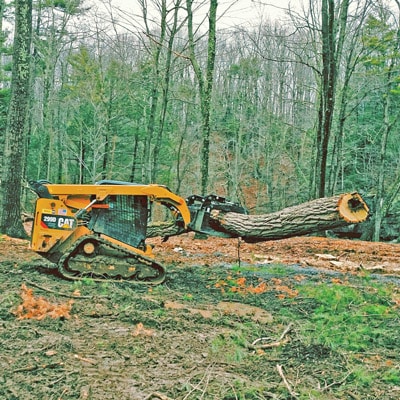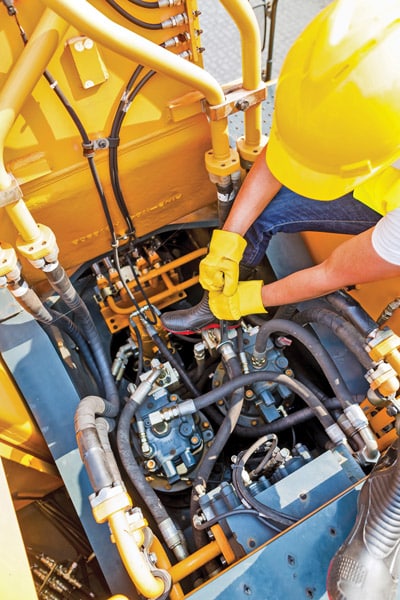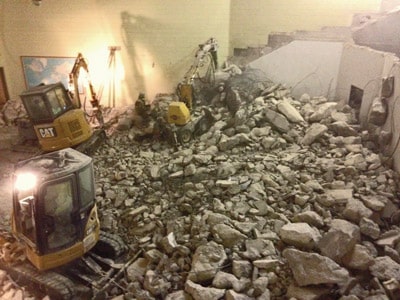We Ask Three National Contractors How They Maintain Their Compact Equipment
Because compact equipment is so broadly utilized by contractors, it is not surprising that equipment maintenance programs also vary. In every case, the goal is to keep the machines running. How that is accomplished is a where the variance occurs. Compact machines benefit from their relatively small size, of course, particularly after designers and engineers made access a priority, so they usually are serviced in-house.
“A compact is for the most part extremely easy to service,” says Kyle Byrne, owner of Trec Management, a construction and land management firm in upstate New York. Trec’s fleet includes four track loaders (three Caterpillar 299D XHPs and a Bobcat T770) and three Cat 305E mini excavators. The company’s service scheduling system is as traditional as it gets: Service logs are kept for each piece of equipment, with clear and complete entries. In addition, mounted filters and other replaceables are hand-labeled with dates and service intervals.
“I am a firm believer in labeling everything,” says Byrne, who believes the redundancy of labels and logs ensures proper servicing. “It is good to have a set of backups. If the operators are checking the fluids as they should be, you want the service dates to stand out to them so they are not overlooked. The dual approach helps back up the shop.”
Byrne says the company also relies on Caterpillar support in the form of a “quick kit” provided to equipment owners at service intervals. The kit contains all replacement parts. “Everything that is needed is in that kit. You don’t have to worry about getting parts numbers for this filter or that filter. It’s all guaranteed to be in there.”

When training operators, try to have them eliminate turning 360 degrees with a track loader because it is all that much more wear on the undercarriage and the tracks.
Miron Construction Co. Inc., headquartered in Neenah, Wis., relies on operators to keep the company’s 15 compact machines regularly maintained. On each jobsite, a couple of operators are charged with this responsibility. Pete Klosterman, vice president of field services for Miron, believes giving operators some ownership of maintenance results in better care of equipment. “It creates productivity during operator downtimes that occur in vertical construction,” he says.
Miron’s compact equipment — the fleet has several brands — frequently is used to demolish concrete and masonry structures. “It is a harsh environment,” observes Klosterman, so regular maintenance is vital. Consequently, Miron technicians service the equipment more frequently than recommended.
“We have shortened up our standard service interval to get more touches with the equipment,” he says. “With extended service on today’s machines, you don’t get to see a piece of equipment as often. We started shortening the service intervals with our trucks and then rolled the practice over into the compact equipment. Regularly getting a fresh set of eyes on a piece of equipment is beneficial.”
Miron does not utilize telematics to watch over large or compact machines in its fleet, nor to track maintenance schedules. Klosterman says company executives “entertain the idea about once a year and kick it around. But, the general contracting industry creates different challenges than earthwork — utilization of equipment and service intervals vary greatly due to the wide variety of tasks we ask of certain equipment.”
Aspen Earthmoving in Carbondale, Colo., quit kicking the idea around a decade ago. Aspen’s equipment manager, Jon Hegland, says it is the only way the company can stay on top of maintaining its 35 pieces of equipment. Consequently, anything larger than the company’s Wacker Neuson walk-behind equipment has a GPS unit mounted on it.
“That’s the way to go,” says Hegland, who has worked at Aspen for a quarter century and personally monitors the telematics data. “You can look up and see where a machine is, if it is sitting, if it is getting run enough — and that can be a problem with little machines; they get parked in a corner. I can track utilization and send up a service order. I can catch problems before they happen. I’m sold on it.”

“We have four different levels of service: A1, A2, A3 and so forth, then B1, B2 and so on,” Hegland explains. “We steer clear of doing anything annually. We do it according to hours operated, mostly at 150-hour intervals. So machines are sometimes completely serviced more than once a year. In each service interval, the technicians do some things that some other shops only do in annual inspections.”
The value of such a maintenance regimen is clear to Hegland. “We just sold some old Bobcat 337 mini excavators that had 7,000 hours on them. It is all about maintenance.” At New York’s Trec Management, compact equipment is given an annual off-season going-over that includes servicing, replacement of worn parts, steam-washing and paint touch-ups. The process for each piece of equipment usually takes two to three days, according to the owner. The undercarriage of a tracked machine is estimated to comprise about 20 percent of its initial cost and perhaps half of its maintenance costs. Protecting that investment comes down to constantly maintaining the undercarriage — and not abusing the machine.
The latter has to do with operation. Trec Management’s Kyle Byrne says a popular impulse when driving a track loader is to spin it, or to repeatedly perform tight 180-degree turns, just because the nimble machines allow it. Wider turns and methods to control slippage of tracks are taught. “When we are training operators, we try to have them eliminate turning 360 degrees because it is all that much more wear on the undercarriage and the tracks, plus you are disturbing the ground underneath.”
Byrne has one 299D XHP loader running on steel tracks for certain operations, but the others ride on rubber. The Bobcat loader is fitted with Solideal rubber tracks that Byrne believes give better traction, though they might not wear as well. Byrne says he normally gets 900 to 1,000 hours between track replacements as his machines work the slopes and rocks of upper New York.
By comparison, Aspen Earthmoving track loaders typically go 1,200 to 1,400 hours on the soils of Colorado’s Roaring Fork Valley, according to Hegland. Aspen operators are required to fuel the equipment at the end of each day and grease all the zerks, but they also are trained to clean the undercarriage of debris and inspect the various moving parts. By clearing away debris, embedded objects or cracked parts come to light. Checking track tension — neither too tight nor too loose — extends the life of the track and its rollers.
All three company executives acknowledge that finding and keeping qualified technicians is a challenge. Yet, they each have done so — two of Aspen’s technicians have worked there 20 years, Hegland says. “I don’t look for a knowledge base in an applicant. I look for attitude. A good work ethic, a good attitude and they have got to be trainable.”
Byrne relies on “dual-purpose guys” to help keep his machines running. “I really like my operators to at least know the basics. It really pays to have an operator who can think outside the box and diagnose a problem. Most have been in a breakdown situation when no one else is there. They are given contact numbers. A simple five-to-10-minute call from a jobsite to a guru can save thousands of dollars.”
Giles Lambertson is a freelance writer for Compact Equipment.






Comments are closed here.